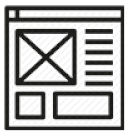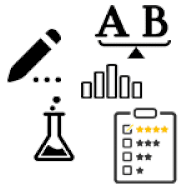

Business Goals
Step number one is to determine what the business is looking to do. What are the project goals, what is the definition of “done” and what are the key metrics for success

User Needs
Once the business need has been understood, the next step is to fully understand what the users want out of the design. After all, if they don’t want it, they won’t use it. Fully understanding who your user is, what they like, what the need, and where they want to go is key to designing a successful product.

Wireframes and Architecture
This is where the rubber starts to hit the road. A wireframe is like a blueprint for a design. It describes the layout to a designer so that they can make it look good. It also describes any functionality to a developer so that they can code it and make it work.

Surveys, Labs, Testing and Metrics
A great idea needs to be tested. If testing ahead of launch isn’t possible, then there should be a strong ability to track and measure the success of the new design. Much can be learned about it though testing and analytics. Improvements to the design should be supported by metrics, whether they be click or in person user testing.

Graphic Design
Once as much pre-work as possible has been completed, we move into a graphic design phase where your style, brand, tone, imagery, fonts, and colour palette will be taken and transformed into the new design. From there, it will get approved by you and cut up into development ready assets.

Build and Test
The development process can take the longest time. Complex designs may require a lot of code. There are a number of different layers that all need to work together such as HTML, CSS, JavaScript, and a number of different frameworks, libraries, and back end server languages.
Testing in this case includes both Quality Assurance (inhouse testing) and User Acceptance Testing (external testing) where the customer tests the design and ensures that it meets the predefined requirements. After this, there is full payment and the product release.